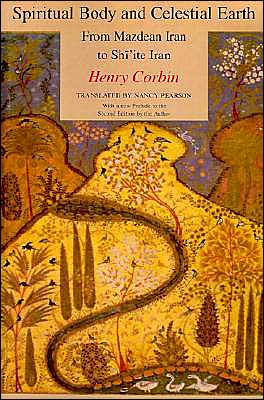

 |

|

The average rating for Spiritual Body and Celestial Earth: From Mazdean Iran to Shi'ite Iran based on 2 reviews is 4.5 stars.
Review # 1 was written on 2012-08-11 00:00:00 Woodrow Breaux Woodrow BreauxHenry Corbin has such a formidable reputation as an expert on Islamic mysticism - and even if he did not, his erudition would immediately jump from the pages of this book anyway - that it is hard to criticize his work without feeling like a dork. Let me put it this way: reading Corbin is like quenching one's thirst from a fire-hose. There is so much force behind the information he presents to the unsuspecting reader that making sense of it takes considerable effort. Part One, which functions as an introduction to his selections of traditional texts, is 105 pages long and replete with information. It eventually coagulates into easily understandable themes but it does so only on page 101. It is then that the title of the book starts making sense: it refers to the Earth of Hurqualya, "a world through which bodies are spiritualized, and spirits embodied...in which the liberated soul, whether in momentary ecstasy or through the supreme ecstasy of death, meets its archetypal 'I,' its alter ego or celestial Image" (p. 101, 103). Corbin discusses his topic with Aristotelian rigor, as he well might: he is equally conversant with Thomistic and Islamic philosophy, both of which were inspired by Aristotle. An endearing reminder of that common heritage is on page 84 where Aristotle is called "the Imam of Philosophers". But there is also a lot of non-Aristotelian vigor. Corbin is clearly a man with a mission. He asks: "What does all this mean for us today? Nothing more nor less than that very thing toward which we are going, which we shape, each one of us, in the image of our own substance." (104-5) Some find his fervor objectionable. To me it is a charming reminder of the pathos that I encountered in the books I found in my grandfather's bookcase when I was a kid. I think it has something to do with erudition, which is out of fashion anyway. Part Two consists of selections from traditional texts by the 12h-century mystic Shihabuddin Yahya Suhrawardi, Muhyiddin ibn Arabi, Daud Qaysari, Abd al-Karim Jili and seven other mystics in chronological order, including Shaikh Ahmad Ahsai, who was the founder of the Shaikhi school in the early 19th century, and two of his successors. Once one gets to Part Two, it is easy to see why Corbin was in such a hurry in Part One. Part Two is the meat of the book. Corbin has selected and translated the traditional texts himself (into French) and reminds his readers time and time again that a lot of work remains to be done to make these texts available to Westerners. It is easy to share Corbin's childlike joy in reading the traditional texts. According to Shihabuddin Yahya Suhrawardi, for instance, "[a]s for the fact of walking on water, gliding through the air, reaching Heaven, seeing the Earth roll up like carpet, these are experiences known to a certain number of mystics" (126). Shaikh Ahmad Ahsai says of the so-called essential body, that "[i]ts capacity to experience enjoyment of food, drink, touch, amorous delights, is seventy times greater than the capacity of the elemental, material body" (198). Corbin mentions the "fourth dimension" in his introduction to Mulla Sadra, who is sixth on Corbin's list of selected texts (164). Reading those texts is like a magic carpet ride (to use a stupid comparison I thought of). Their nature being radically different from what Corbin calls "literalist" Islam, Corbin elaborates on the pre-Islamic thought of Mazdean Iran at length in Part One. It is the pre-Islamic thought that animates Shiite Islam in general and mysticism in particular. It is on that point that he does something I don't think I can completely agree with. He says that people reduce the origins of Shiite Islam to questions of political succession, while he attributes the flowering of Shi'ism to the resurgence of pre-Islamic gnosis in Islam (57). Point taken. He just dismisses the question of succession, not only political but also spiritual succession, too easily as a historical curiosity or a contemporary fad. It is too bad that he in no way even implies that the Shaikhi school was later more or less absorbed by the Baha'i Faith (which he does not mention). The Baha'i Faith emphasizes succession, not so much political as spiritual succession, while diminishing mystical experience. My point is that Corbin's lack of emphasis on succession obfuscates the historical chronology as a whole. It is quite hard to put the selected texts on a timeline because Corbin does not expand their historical context, apart from providing a short introduction to the texts and their authors (109-117). There is no question this book is a masterpiece. The criticisms I may have only facilitate dialogue with it rather than undermine its credibility. |
Review # 2 was written on 2019-06-09 00:00:00 Bradley Kidwell Bradley KidwellThese texts and Corbin's introduction invite the imagination into the most vivid and strange places. A fascinating religious thinking that sacralises the imagination, whose adepts learn to see through the world to the soul behind it. 'In our terrestrial world, our inner states are invisible And the aspect of what we do is limited to the outer, Observable appearance, But in the the celestial earth the same actions assume another form and inner states Project visible forms. Some take the forms of palaces, others the form of houris, or of flowers, plants, trees, Animals, gardens, streams of running water, and so on.' |
CAN'T FIND WHAT YOU'RE LOOKING FOR? CLICK HERE!!!